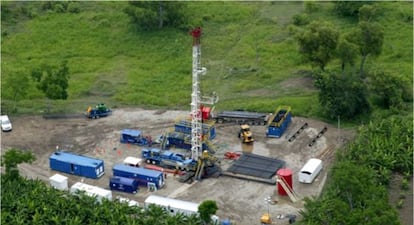Mexico opens up Chicontepec oilfields to foreign multinationals
The crude-rich region holds much promise but also poses huge technical difficulties


When it comes to Mexico’s oilfields, the jewel in the crown is the Chicontepec Basin. This region of 3,800 square kilometers that straddles the northern portions of Veracruz and Puebla contains 40 percent of the country’s hydrocarbon reserves.
Mexico’s new energy reform, which will allow private investment in the oil industry for the first time in 76 years, means this area will now be wide open to multinationals. Of the 169 fields that will be offered to new companies, 90 are located in Chicontepec.
The area may hold a treasure of 139 billion barrels of crude, but it has also caused the Mexican government endless headaches. Discovered in 1926, exploitation only began 30 years later, and Chicontepec’s geological complexity has prevented operators from extracting significant amounts of oil there.
The complexity of the Chicontepec oilfields is no secret
Petróleos Mexicanos (Pemex), once in charge of the nation’s entire oil industry, was only able to produce 74,000 barrels in Chicontepec a day. By comparison, oilfields such as Cantarell and Ku Maloob Zaap, in the Gulf of Mexico, can pump out over 800,000 barrels a day.
Former president Felipe Calderón, who was in power between 2006 and 2012, introduced a timid reform that allowed private companies to provide services to the industry. “Chicontepec is a successful project that is making the future of Mexico’s oil industry viable,” he said on November 25, 2012, five days before his presidency ended. But those plans never came to fruition.
“Those oilfields are very small and require new technology, very likely fracking,” explains Dante San Pedro, an energy lawyer who helped draft that 2008 energy reform. “It poses great challenges and technological risks, and only a company with knowledge and experience can take that kind of a risk.”
Those oilfields are very small and require new technology, very likely fracking”
In 2013, Pemex offered the big oil companies six fields in the region and promised that for every barrel of extra heavy crude they would get a rate of up to $6.50. Only three companies were interested: Baker Hughes, Weatherford and Halliburton. Three oilfields ended up deserted.
Rumor had it that new president Enrique Peña Nieto, of the Institutional Revolutionary Party (PRI), was going to introduce a new energy reform bill, and several companies decided to wait and see if they could secure better conditions.
The complexity of the Chicontepec oilfields is no secret. In 2010, the National Hydrocarbon Commission (CNH) drafted a controversial report underscoring the technical difficulties and the high compensation costs for the local population, as well as the environmental risks of using aggressive extraction techniques. The report also criticized Pemex for not living up to expectations in Chicontepec.
Tu suscripción se está usando en otro dispositivo
¿Quieres añadir otro usuario a tu suscripción?
Si continúas leyendo en este dispositivo, no se podrá leer en el otro.
FlechaTu suscripción se está usando en otro dispositivo y solo puedes acceder a EL PAÍS desde un dispositivo a la vez.
Si quieres compartir tu cuenta, cambia tu suscripción a la modalidad Premium, así podrás añadir otro usuario. Cada uno accederá con su propia cuenta de email, lo que os permitirá personalizar vuestra experiencia en EL PAÍS.
¿Tienes una suscripción de empresa? Accede aquí para contratar más cuentas.
En el caso de no saber quién está usando tu cuenta, te recomendamos cambiar tu contraseña aquí.
Si decides continuar compartiendo tu cuenta, este mensaje se mostrará en tu dispositivo y en el de la otra persona que está usando tu cuenta de forma indefinida, afectando a tu experiencia de lectura. Puedes consultar aquí los términos y condiciones de la suscripción digital.
Últimas noticias
Most viewed
- Alain Aspect, Nobel laureate in physics: ‘Einstein was so smart that he would have had to recognize quantum entanglement’
- Maps of the US attack on Venezuela: Targets, airspace and deployed fleet
- Key points of the military attack on Venezuela: Early morning bombings and a ‘captured’ president
- David King, chemist: ‘There are scientists studying how to cool the planet; nobody should stop these experiments from happening’
- Nicolás Maduro, the autocrat of an isolated Venezuela who had no intention of surrendering








































